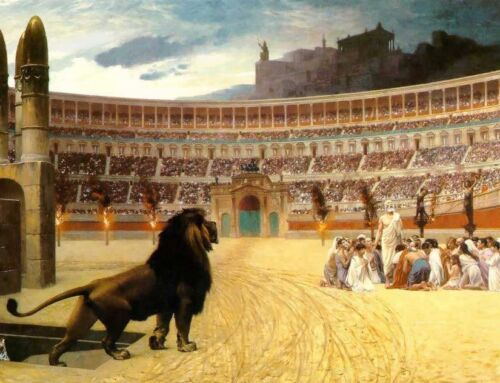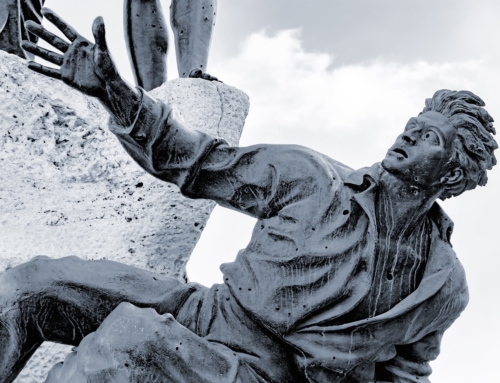Although the small rural town of West Nickel Mines in Lancaster County, Pennsylvania, might not be familiar to most, the tragic shooting of Amish schoolchildren that took place there in 2006 probably is. It is notably one of the saddest incidents in the whole history of school shootings in this country, but it is also one of the most inspiring.
And there is much more to the story than meets the eye.
Angels atop Schoolhouses
In recounting the incident in the book, Faith Under Fire, Catholic author Matt Archbold tells of the schoolteacher, Emma Mae Zook, who heard a clear voice inside her head as a man with a shotgun entered her one-room schoolhouse. The man turned his back for a moment to pull down the window shades, and the voice told her, “Now would be a good time to run.”
And run she did. As she went to call for help, she glanced back at the schoolhouse for a brief second and saw what looked like an angelic figure hovering above it. It’s hard to judge whether this was actually a holy angel or a kind of psychological projection on her part, but the teacher said it caused a deep sense of peace while the events of October 2nd, 2006 were transpiring.
Whether authentic or not, the incredible irony of the teacher’s vision above the schoolhouse is that October 2nd is the feast of the Guardian Angels in the universal Christian calendar.
The man who entered the schoolhouse was a 32-year-old milk truck driver named Charles Carl Roberts who had never previously had a problem with the law and was, by all accounts, an upstanding citizen.
Until he wasn’t.
Roberts was married and the father of small three children, whom he and his wife had walked to the bus stop earlier that morning. As he saw the kids off, he hugged them and told them he loved them. He knew he would never see them again. It was the day he had set to carry out a modern day Herodian massacre of the innocents.
Something Evil Entered
Still, it is hard to piece together any motive for the mass murder of children given what we know of the killer.
Roberts’ wife had gone to a prayer meeting that morning, and in her absence he wrote four garbled suicide letters to her and the children before he left home to commit the crime. In those notes he confessed to having perpetrated some horrible abuse on a number of children years earlier, but the persons named in the notes later claimed to have no knowledge of any abuse. Strange. He also said he was mad at God for a miscarriage his wife had endured some years before.
From the evidence available, we are left with one of three possibilities as to why:
- that Roberts had some kind of psychotic break (not likely given the premeditated nature of the crime and the fact that such breaks typically happen in adolescence);
- that he always had been severely mentally ill (but there was no evidence of that in his life); or
- that something truly evil had gotten into him – with very few warning signs or clues.
I am not prone to spiritualizing incidents like this, but whenever I see inexplicable violence dealt with such brutality, I wonder if the perpetrator had actually been overtaken by some demon with whom the person voluntarily cooperated for some unknown reason. (The horrific Virginia Tech massacre, for example – only six months after the Amish event – bears every mark of a demonically motivated killing spree.)
Whatever the cause, the result was simply catastrophic.
The Darkness: “I’m not Coming Home”
For the sake of brevity and modesty, I will condense the shooting incident that morning into a simple timeline so we can focus on the real lesson of goodness we wish to draw out of it.
Roberts entered the schoolhouse at 10:25 a.m. under the pretext of looking for something he had lost. During two trips in and out of the schoolhouse to retrieve guns and materials, the teacher, her mother, and a nine-year-old girl escaped. After that, he ordered a pregnant volunteer and three parents with toddlers, as well as all 15 boys of the class to leave. When they did so, Roberts began tying up the ten girls who remained and forcing them to lie down in front of the chalkboard. The girls’ ages ranged from 6 to 13.
Roberts barricaded the doors and created a hostage situation. Six minutes later he heard sirens (due to Emma Mae’s call) and then dialed 9-1-1 to tell the police to stay away from the schoolhouse or he would kill everyone inside. He further called his frantic wife who had found the suicide notes by this time: “I’m not coming home,” he said roughly. “The police are here.” (Click.)
The Light: “Shoot Me First”
The account is almost too incredible to believe, but the surviving girls were eye-witnesses to it: at that very moment, thirteen-year-old Marian Fisher spoke out. In a forthright, clear voice, she said to the killer, “Shoot me first and leave the other ones loose.”
Her intrepid eleven-year-old sister, Barbie, then spoke out in the wake of the older girl’s courage: “Shoot me next,” she said.
Were they trying to buy time while the murderer toyed with the police? Were they bluffing? Or did these girls have the adamant courage of the early Church martyrs who threw themselves at their persecutors and ran to their deaths?
In light of what transpired, the only option we can discount is the bluffing: the girls were entirely sincere. They wanted to offer themselves so that the others could live.
Matt Archbold captured the incident perfectly: “This is a moment we should all measure ourselves against.”
Caught off guard by their offer, Roberts looked at the girls and asked them to pray for him…before he opened fire on them. Can you imagine?
Above, I mentioned the heinous nature of this crime. It was not only that he killed innocent children but that he killed them execution style.
Of the ten captives in the schoolhouse that morning, Roberts killed five and wounded the other five because at the sound of the gunfire the heroic police broke the windows and stormed the room, which kept him from killing the remaining girls.
Roberts fired erratically at the police too, but then he suddenly stopped…and turned the gun on himself, fatally. By 11:07 am (32 minutes later) it was all over.
An investigator later noted that “there was not one desk, not one chair, in the whole schoolroom that was not splattered with either blood or glass. There were bullet holes everywhere, everywhere.”
The ages of the five girls who died were 13, 12, 8 (two girls), and 7. The survivors were 13, 12, 11, 8, and 6. The older girl who spoke out, Marian Fisher, had been the first to die. Her sister Barbie was wounded and lives to this day.
“No one has greater love than this, to lay down one’s life for one’s friends.” (John 15:13)
The Story Doesn’t End There
Given the horror of the event, it’s hard to fathom the kind of flawless Christian response displayed by the entire Amish community in the aftermath of the atrocious massacre of their own children. As the world looked on in shock and the political opportunists began their calls for gun control, the small Amish community, as one, issued a statement stating forthrightly that they had forgiven the shooter for his terrible deeds.
Within six hours of the event, the Fisher family who were most affected by the crime actually reached out to Roberts’ widow and family to let them know that they (the Fishers and the community as a whole) did not hold any of them to blame and sought to comfort them in their own grief and horror.
The Amish community, in an outpouring of human decency, recognized that the Roberts family were victims too and invited them to the funerals of the children. They even sent a delegation of a dozen members to attend the shooter’s funeral.
There is a lesson for all of us in this. A Christian community that does not immerse itself in our poisoned culture but lives a life that is permeated by the Gospel differs from the rest of us who really live in the secular rather than the Christian world – and are often affected negatively by the poisoned values of a corrupt world. Such a spontaneous display of heroism in a moment of extreme crisis is not in itself miraculous – it’s the product of a culture that embraces those Gospel values deeply and without compromise.
“Do not be conquered by evil but conquer evil with good.” (Romans 12:21)
A Final Question
If Emma Mae Zook’s vision was true and God really did send an angel to hover over the schoolhouse, it’s fair to ask why the angel didn’t stop the massacre.
But maybe the better question is why should we think he didn’t?
Neither God nor His holy angels nullify the gift of free will just because some people abuse it for evil, so in that sense, the angel didn’t stop the perpetrator from committing some evil that day. True.
However, six women, one girl, four children, fifteen boys and five of the ten hostages – 31 people in all – had direct contact with the gunman that day and were not killed. And despite being shot at, no policemen were killed or wounded.
Faith requires us to see the whole picture – from the perspective of the angels, as it were.
More importantly, five innocent girls are alive today whose scars tell the story of the amazing grace that was poured out on a truly diabolical act.

Soul Work
Our personal Christian values keep us vigilant toward sin, and that’s a good thing for our souls. A society’s Christian values also preserve that society from social sin. Crime and chaos are evident in some way in every society, but imagine what would our world would be like without the “light and salt” of the Gospel.
Few are called to exhibit the heroism of the Amish girls or their community, but all of us are called to witness and practice our values in a public way.
How do you witness the Christ in your immediate social circle? Are there challenges in your life or family integrity that need a strong statement of Christian truth right now?
Above all, pray for the grace to be able to offer that witness in a time of testing.
———-
[This article is a reproduction of the Sacred Windows Email Newsletter of 08/22/21. Please visit our Newsletter Archives.]




Leave A Comment